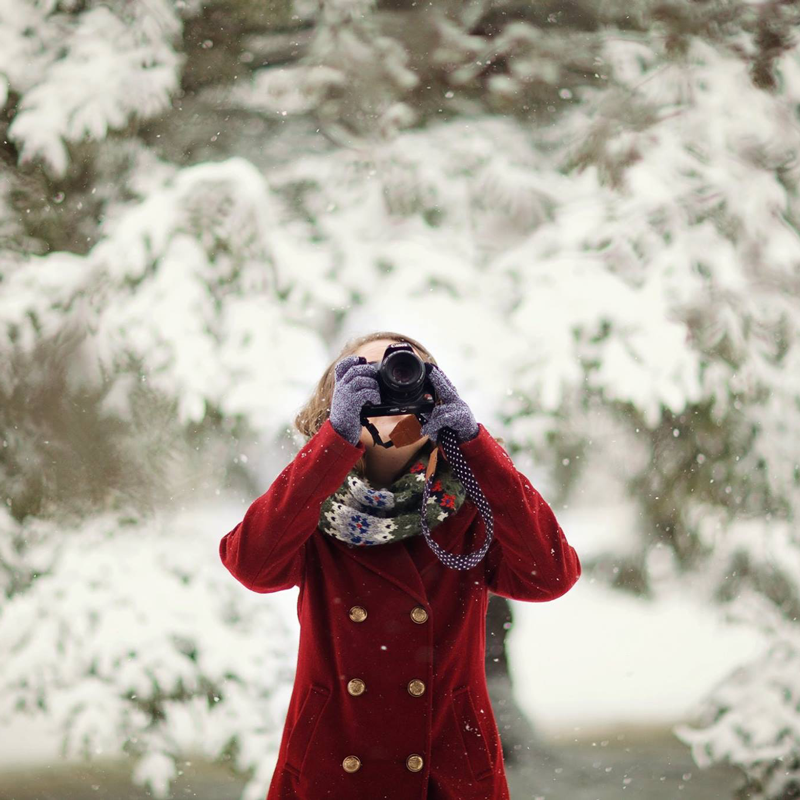Interested in photography but not quite sure where to start? If snapping photos with your smartphone has become second nature but you’re ready to graduate to some real gear, read on to learn what five things you’ll need to get going.
A Digital Camera
Okay, we know this first one is a little obvious, but there are a few options to consider when it comes to cameras. Unlike its film-based predecessors, a digital camera makes it easy to immediately access and share your images. But while Digital Single Lens Reflex (DSLR) cameras have been the go-to for the last 20 years, mirrorless digital cameras are becoming increasingly popular. Often smaller and lighter because of their streamlined construction and no built-in mirror, mirrorless cameras allow you to take faster, quieter photos with sharper image quality. Some mirrorless systems use an LCD screen to frame a shot, rather than an electronic viewfinder (EVF) which can sometimes compromise image quality due to decreased stabilization (you don’t have to hold the camera as close to your body to compose your shot).
Most DSLRs employ an optical viewfinder (OVF), which uses prisms and mirrors to display the image you’re going to shoot. There’s no time lag or increased battery drain with an OVF, but an EVF offers immediate feedback as you change settings to refine your image. We’d suggest trying out some different DSLR and mirrorless models in the store to see which one meets your preferences. Some entry-level options include:
- Canon EOS Rebel T7 with 18-55mm IS II Kit (DSLR)
- Nikon D5600 DX Digital SLR Camera with 18-55mm DX VR II Lens Kit (DSLR)
- Sony α6100 Mirrorless Digital Camera with E-Mount 16-50mm Lens Kit (Mirrorless)
- Nikon Z50 Mirrorless Digital Camera with 16-50mm Lens Kit (Mirrorless)
Lenses
A distinct advantage of owning a DSLR or mirrorless camera as opposed to your old point-and-shoot is that you can achieve more diversity in your image composition with interchangeable lenses. Some cameras come with a kit lens, which is typically an 18-55mm zoom and is great for helping you get to know your camera.
If you want to do more with your camera, though, try a prime or fixed lens. These lenses don’t have the capability to zoom in on your shot, which can help teach you about proper composition techniques and camera functionality. A prime lens forces you to think through your shot, which improves your overall skills as a photographer. An affordable option for beginners is a “nifty fifty,” or 50mm lens. These lenses most closely approximate what you naturally see through the human eye. You’ll want to be sure to select a lens that works with the type of camera you’ve selected, but a few suggested examples include:
A Tripod
A tripod is an extremely useful piece of photographic equipment but is often overlooked. Useful in low-light settings, the increased camera stability provided by a tripod lets you take long exposure shots without any camera shake. It’s perfect for night-time shots, sunsets, close-ups, or nature photography. A good tripod also provides additional stability when using telephoto lenses or shooting sports. Most tripods also require a ball head, which helps you adjust the position of the camera. Good ones will lock tightly so that the camera doesn’t slip out of position. Some options for tripods with included ball heads are:
- MeFOTO RoadTrip Travel Tripod Kit
- Manfrotto Befree Advanced Travel Aluminum Tripod w/494 Ball Head
- Benro Slim Travel Kit Aluminum Tripod
Lighting
A good flash helps you fill in the shadows and eliminate sharp contrast, softening the overall composition of the image. This is especially important when shooting portraits or weddings, even outdoors. There are endless options for capturing, diffusing and modifying light in your images, but a good place to start is with an external flash. Also called a speedlight or hot shoe flash, these small, battery-powered flashes are designed to work both on and off camera. They are lightweight, easy to use, and much more effective than the built-in flash on your camera body.
Select a speedlight that allows you to angle the flash so you can bounce light off ceilings or walls for indirect lighting options. Many speedlights also have fill cards and diffusers, which also help you modify the light from your flash. Some brands, like Godox, are made to work on several different types of cameras but make sure you select a flash that works with your existing equipment. Some good beginning lighting includes:
Bags
While a camera seems simple enough to carry on its own, resist the urge to toss it into your backpack or purse. You’ve already invested a lot in your camera equipment—it's worth investing a little more to properly protect it. Before you begin shopping, consider what equipment you’ll be shooting with most often, how you’ll be transporting the bag, and what the conditions are the majority of the time you’re using the bag. This will help you narrow down the size of the bag you’ll most likely need, as well as the durability of the construction and materials.
Well-designed bags have compartments specifically sized for cameras, lenses, and other related equipment, or can easily be configured with removable dividers so that you can customize the bag to suit your specific needs. The advantage of these specially designed, dedicated camera bags is that they keep your camera and other equipment secure and make it easy for you to access what you need. Across most of the available brands, you can find a range of sizes, styles and colors—even bags that can accommodate a laptop and additional editing equipment. A few examples include:






